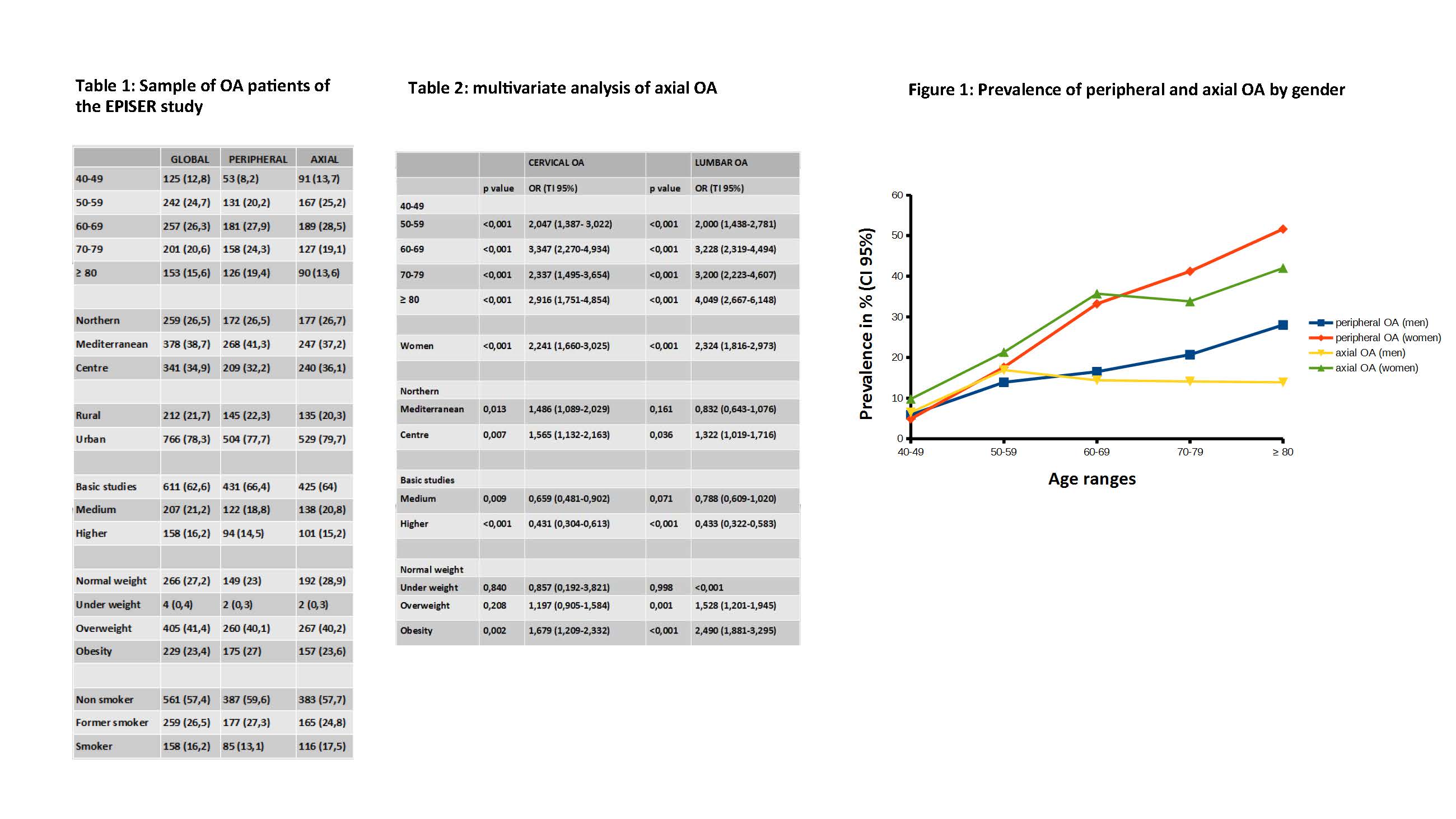Session Information
Session Type: Poster Session (Monday)
Session Time: 9:00AM-11:00AM
Background/Purpose:
Osteoarthritis (OA) is a heterogeneous group of diseases with common clinical and radiographic manifestations involving the peripheral and axial skeletal. OA is the most prevalent rheumatic disease. There are very few publications focused in axial OA. In 2016, the Spanish Society of Rheumatology (SER) started a population descriptive study (EPISER 2016) to analyze the prevalence of 13 rheumatic diseases in Spain, including peripheral (hip, knee and hand) and axial (cervical and lumbar spine) OA.
OBJECTIVES: To estimate in adult population the prevalence in Spain of symptomatic OA of hand, knee, hip, cervical and lumbar spine and associated factors.
Methods:
EPISER 2016 study is a cross-sectional, population-based descriptive study. To estimate the symptomatic OA prevalence, adult population aged 40 or older was selected. The initial recruitment was made through by a call center. In a second phase rheumatologists confirmed the diagnosis. Diagnostic criteria to confirm new diagnosis of peripheral OA were ACR criteria of hand, knee and hip. The axial OA diagnostic criteria to confirm new diagnosis were both clinical and radiographic. Clinical criteria: mechanical pain longer than 3 months of evolution and stiffness of less than 30 minutes or absence of it; and radiographic criteria: vertebral osteophytes or reduction of intervertebral space with sclerosis of vertebral plate and sclerosis in interapofisary joints. To confirm the diagnosis, it was necessary that both clinical criteria and at least one radiographic criterion were met.
Results:
The sample of the EPISER study was 3,336 subjects ≥ 40, of whom 978 had peripheral or axial OA. The mean age was 64.72 years, 730 were women, 62.6% had basic education, 64,8% were overweight or obese and 83,9% were ex-smokers or non-smokers . The prevalence of global OA (peripherical+axial) was 29.35%. Prevalence of peripheral and axial OA was 19,62% and 19,17% respectively. According the prevalence of polyarticular phenotypes, the phenotype combining axial and peripheral OA was 9,66% and the phenotype combining OA in 2 or more peripherical joints (hand, knee o hip) was 5,64%.
The characteristics of patients with peripheral and axial OA follow similar patterns (Table 1).
Prevalence of cervical OA was 10.10%. In the multivariate analysis, it was observed that cervical OA is more frequent in women and older subjects, with the prevalence peak between 60-69 years. It is also more frequent in subjects with obesity and in subjects with a basic education level (Table 2 and Figure 1).
Prevalence of lumbar OA was 15.52%. Multivariate analysis also showed that lumbar OA is more frequent in women and it increases with age (prevalence peak in ≥80 years). Greater association was observed with obesity or overweight and with basic study levels. Lumbar OA prevalence was higher in population from centre of Spain compared with other areas.
Conclusion:
EPISER2016 study shows similar prevalence of peripheral and axial OA. Lumbar OA is more prevalent than cervical OA. Axial OA in Spain is more frequent in women, increases with age with a peak between 60-69 years for cervical OA and ≥ 80 years for lumbar OA. Both cervical and lumbar OA are more frequent in patients with obesity or overweight and with basic studies.
To cite this abstract in AMA style:
Silva-Díaz M, Blanco F, Quevedo Vila V, Seoane-Mato D, Bustabad-Reyes S, Proyecto EPISER2016 o. Prevalence of Symptomatic Axial Osteoarthritis and Poliarticular Phenotypes in Spain: EPISER 2016 Study [abstract]. Arthritis Rheumatol. 2019; 71 (suppl 10). https://acrabstracts.org/abstract/prevalence-of-symptomatic-axial-osteoarthritis-and-poliarticular-phenotypes-in-spain-episer-2016-study/. Accessed .« Back to 2019 ACR/ARP Annual Meeting
ACR Meeting Abstracts - https://acrabstracts.org/abstract/prevalence-of-symptomatic-axial-osteoarthritis-and-poliarticular-phenotypes-in-spain-episer-2016-study/

